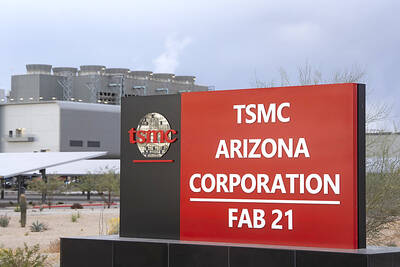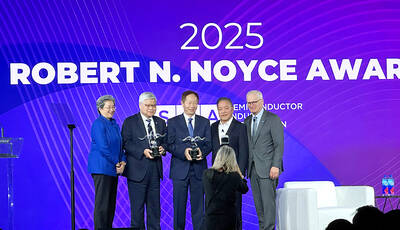ASE Technology Holding Co (ASE, 日月光投控), the world’s biggest chip packaging service provider, yesterday said it plans to spend NT$5.26 billion (US$162.15 million) acquiring a manufacturing facility from an affiliate as part of its latest efforts to expand advanced packaging capacity.
ASE is to acquire a fab, named K18, in Kaohsiung’s Nanzih District (楠梓) from Hung Ching Development and Construction Co (宏璟建設), ASE chief financial officer Joseph Tung (董宏思) told an online media briefing yesterday.
Advanced Semiconductor Engineering Inc (日月光半導體), a major subsidiary of ASE, jointly built the fab with Hung Ching. Advanced Semiconductor owns a 25 percent share in the fab.

Photo: CNA
Advanced Semiconductor also signed a cooperative development contract with Hung Ching in June 2020 to build the K13 plant, which was renamed the K18 plant.
“To accommodate the future operational growth of Advanced Semiconductor’s Kaohsiung plant, Advanced Semiconductor intends to exercise its right of first refusal to purchase the K18 plant from Hung Ching to meet the needs of expanding advanced production capacity,” Tung said.
ASE plans to add bumping and flip-chip packaging capacity at the K18 fab, Tung said.
Similarly, ASE in June said that it would jointly build a new plant, called K28, in Kaohsiung in cooperation with Hung Ching.
The capacity expansion aims to cope with growing demand for advanced packaging services used in artificial intelligence (AI) chips and high-performance computing (HPC) chips.
The fab is expected to start operations in the fourth quarter of 2026.
ASE has also expanded its advanced testing and packaging capacity overseas.
The company last week said it plans to buy 16 hectares of land in Kyushu, Japan, for about NT$701 million in preparation for building an advanced testing and packaging plant there.
ASE last month launched its second testing facility in San Jose, California, to expand advanced chip testing capacity such as burn-in testing to satisfy customers’ rising engineering needs for emerging semiconductor applications such as AI and HPC.
ISE Labs, fully owned by ASE, has spent about US$500 million on the company’s US labs and hired more than 200 Taiwanese employees.
Separately, ASE yesterday posted 6.7 percent annual growth in revenue for last month, rising from NT$48.35 billion to NT$51.6 billion and hitting the highest level since December last year.
On a monthly basis, revenue expanded 10 percent from NT$46.93 billion, a company filing with the Taiwan Stock Exchange showed.
During the first seven months, ASE has accumulated NT$324.64 billion in revenue, increasing 2.89 percent from NT$315.52 billion for the same period last year.

Shiina Ito has had fewer Chinese customers at her Tokyo jewelry shop since Beijing issued a travel warning in the wake of a diplomatic spat, but she said she was not concerned. A souring of Tokyo-Beijing relations this month, following remarks by Japanese Prime Minister Sanae Takaichi about Taiwan, has fueled concerns about the impact on the ritzy boutiques, noodle joints and hotels where holidaymakers spend their cash. However, businesses in Tokyo largely shrugged off any anxiety. “Since there are fewer Chinese customers, it’s become a bit easier for Japanese shoppers to visit, so our sales haven’t really dropped,” Ito

The number of Taiwanese working in the US rose to a record high of 137,000 last year, driven largely by Taiwan Semiconductor Manufacturing Co’s (TSMC, 台積電) rapid overseas expansion, according to government data released yesterday. A total of 666,000 Taiwanese nationals were employed abroad last year, an increase of 45,000 from 2023 and the highest level since the COVID-19 pandemic, data from the Directorate-General of Budget, Accounting and Statistics (DGBAS) showed. Overseas employment had steadily increased between 2009 and 2019, peaking at 739,000, before plunging to 319,000 in 2021 amid US-China trade tensions, global supply chain shifts, reshoring by Taiwanese companies and

Taiwan Semiconductor Manufacturing Co (TSMC, 台積電) received about NT$147 billion (US$4.71 billion) in subsidies from the US, Japanese, German and Chinese governments over the past two years for its global expansion. Financial data compiled by the world’s largest contract chipmaker showed the company secured NT$4.77 billion in subsidies from the governments in the third quarter, bringing the total for the first three quarters of the year to about NT$71.9 billion. Along with the NT$75.16 billion in financial aid TSMC received last year, the chipmaker obtained NT$147 billion in subsidies in almost two years, the data showed. The subsidies received by its subsidiaries —

Taiwan Semiconductor Manufacturing Co (TSMC) Chairman C.C. Wei (魏哲家) and the company’s former chairman, Mark Liu (劉德音), both received the Robert N. Noyce Award -- the semiconductor industry’s highest honor -- in San Jose, California, on Thursday (local time). Speaking at the award event, Liu, who retired last year, expressed gratitude to his wife, his dissertation advisor at the University of California, Berkeley, his supervisors at AT&T Bell Laboratories -- where he worked on optical fiber communication systems before joining TSMC, TSMC partners, and industry colleagues. Liu said that working alongside TSMC